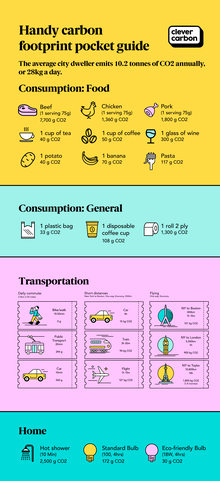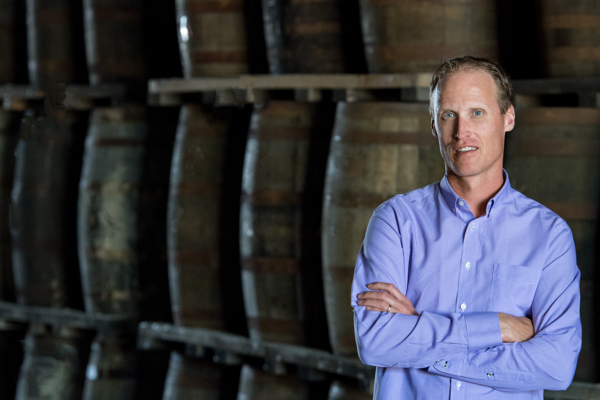
The importance of carbon literacy
Do you know your own carbon footprint? Michelle Li (BSc ‘05) shares why you should care.

Do you know your own carbon footprint? Michelle Li (BSc ‘05) shares why you should care.
By Yelda Safi Co-op student, Office of AdvancementFrom worldwide protests to the recent United Nations Climate Change Conference (COP26), climate change is a hot topic in the media and news today. You may have heard of carbon emissions and carbon footprints before. But what does it really mean? How does it apply to our daily lives and personal choices? What actions can we take to reduce them?
It all begins with knowing your own carbon footprint, says Michelle Li (BSc ‘05). Michelle is the founder of Clever Carbon, an organization that promotes carbon footprint literacy. With their colorful graphics and cheeky captions, Clever Carbon knows how to catch your attention and teach about carbon footprints in a fun and engaging way.
We caught up with Michelle to learn more about her sustainability journey. Here, Michelle shares how she came to launch Clever Carbon, why carbon footprint literacy is important and tips on how to reduce your carbon footprint.
Michelle didn’t set out to become a climate entrepreneur. After graduating from the Bachelor of Science program at Waterloo, Michelle went on to pursue a master’s degree in genetics at the University of Toronto. After that, she worked at a medical device market research company for four years.
Later Michelle moved to San Francisco to pursue an MBA. While living in Silicon Valley for seven years, Michelle worked different tech jobs for companies like Salesforce and DocuSign.
While she was always passionate about sustainability, her sustainability journey really took off when she moved to London.
“In 2017 I went vegan, I had a reusable shopping bag and reusable coffee mug and I thought I was being very eco-friendly,” she says. “But it wasn't until I moved to London in 2019 that it really opened my eyes to what sustainability could mean.”
In London, Michelle describes, there are many options to go plastic free: from refilling shampoo bottles at her local convenience store to zero-waste feminine care products. To learn more about sustainability, she also volunteered with Plastic Free Hackney, a local nonprofit organization.
In her experience, Michelle found many people were not interested in learning about sustainability and carbon footprints, even though there are so many resources with great information available.
“I didn't know what my carbon footprint was, but I was vegan for so long and I cared about sustainability,” Michelle says. “I’d heard the term carbon footprint, but I thought it applied to countries and manufacturers. The more research I did, the more I learned that we all have carbon footprints. But like all the resources out there, the ones I found were very technical. It’s very difficult to understand what a carbon footprint really is.”
Thrilled with her newfound knowledge, Michelle wanted to spread awareness in a way that is positive and engaging.
“While a lot of the nonprofits give really good information and content, most people aren't interested because it's not packaged in a way that they can relate to,” Michelle says. “So, I set out to start clever carbon because I wanted to give consumers a brand that was really hip, really fun, that they could relate to and that didn’t make sustainability feel like it's the end of the world, it's an emergency, it's a crisis. I wanted to show that sustainability is something clever and smart that you can know or that you can do. So we package the information in a hip, fun way, but also teach a very concrete skill: carbon footprint literacy.”
 Michelle launched Clever Carbon in April of 2020, a short while after the pandemic hit. Michelle describes the pandemic as a great time for her to start Clever Carbon. The extra time she gained during quarantine motivated her to start something she was passionate about.
Michelle launched Clever Carbon in April of 2020, a short while after the pandemic hit. Michelle describes the pandemic as a great time for her to start Clever Carbon. The extra time she gained during quarantine motivated her to start something she was passionate about.
“For me, it was never about making money. It was just about having a tool that people can use to learn and that's kind of how the company so to speak was born,” she says.
Clever Carbon has two main goals, as Michelle put. The first is to use hip and fun branding to teach people about carbon footprints and support their sustainability journeys. Then, once people are aware, they can join in the second goal: advocating for carbon labels.
What are carbon labels? Think of them like nutrition labels.
“When brands carbon label they essentially show the emissions associated with a product, the manufacturing process, transport process, product use and disposal,” Michelle explains.
Like nutrition labels, carbon labels allow consumers to make more informed decisions about their footprints. Michelle points out that many consumers would prefer to buy products with lower carbon footprints and that will motivate manufacturers to reduce their carbon emissions and incorporate sustainable business practices.
“There are companies that carbon label, but there aren’t a lot of them —mostly because people are not aware of what carbon footprint is. So hopefully, if more people know what a carbon footprint is, they'll advocate for carbon labels and we'll have more transparency and accountability for manufacturers,” says Michelle.
Clever Carbon began simply as a website that hosted the carbon footprint quiz. Now they have grown and offer many more free resources and educational items on their website, including a carbon footprint lesson plan for teachers and their popular Coffee Menu that lists the current footprint per coffee ingredient to display in coffee shops.
They recently launched Clever Actions, a program designed for businesses and employers to use and engage with in the workplace. A free corporate sustainability program, Clever Actions offers over 70 different sustainable activities that a company can do and are rewarded in a point system. These activities include having a clothing swap party instead of Secret Santa with your employees or offering a team vegan lunch.
A year and a half after the launch of Clever Carbon, over 15,000 people have taken their carbon footprint quiz. This impressive accomplishment is the result of their dedicated international team of volunteers, from places like Jakarta and Copenhagen. To increase awareness, Clever Carbon has translated their quiz into different languages. Currently the quiz can be done in Chinese, Japanese, Korean, Spanish and Farsi.

Read more
Canadian whisky is as diverse as Canada itself. Let award-winning master blender Don Livermore (BSc ’95) help you find your new favourite.

Read more
Rahim Thawer (BA '08) shares the student experiences that led him to a career in social work

Read more
Four alumni recommendations to advance your career
The University of Waterloo acknowledges that much of our work takes place on the traditional territory of the Neutral, Anishinaabeg, and Haudenosaunee peoples. Our main campus is situated on the Haldimand Tract, the land granted to the Six Nations that includes six miles on each side of the Grand River. Our active work toward reconciliation takes place across our campuses through research, learning, teaching, and community building, and is co-ordinated within the Office of Indigenous Relations.